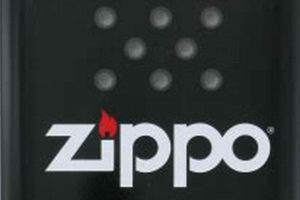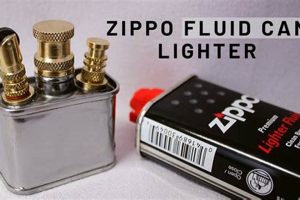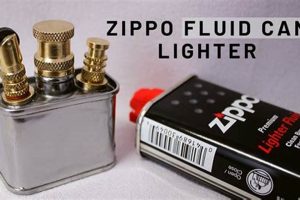Using charcoal lighter fluid in a Zippo-style lighter is generally discouraged. These lighters are designed for a specific type of refined petroleum distillate, typically referred to as lighter fluid. Charcoal lighter fluid, while also a petroleum distillate, is formulated differently. It often contains heavier hydrocarbons and other additives intended for igniting charcoal briquettes, not maintaining a small, controlled flame in a pocket lighter.
The difference in formulation is significant. Heavier hydrocarbons in charcoal lighter fluid can leave gummy residues, clogging the wick and hindering the lighter’s mechanism. Additives designed for charcoal ignition can produce unpleasant odors and potentially damage the lighter’s internal components over time. Using the correct fuel helps ensure the lighter’s longevity and optimal performance. Historically, Zippo-style lighters have been renowned for their reliability, often attributed, in part, to the use of the appropriate fuel.
The following sections will delve deeper into the specific reasons for avoiding charcoal lighter fluid in Zippo-style lighters, discuss the proper fuel types, and explore maintenance procedures to keep these iconic lighters functioning smoothly.
Tips for Zippo Lighter Fuel
Maintaining a Zippo lighter’s functionality and longevity depends significantly on using the correct fuel. These tips offer guidance on fuel selection and related practices.
Tip 1: Use Zippo Premium Lighter Fluid. Zippo’s own premium lighter fluid is formulated specifically for optimal performance in their lighters. This minimizes residue buildup and ensures a consistent flame.
Tip 2: Consider other high-quality lighter fluids. While Zippo premium fluid is recommended, other high-quality lighter fluids specifically designed for wick-style lighters can be suitable alternatives.
Tip 3: Avoid charcoal lighter fluid. Charcoal lighter fluid contains heavier hydrocarbons and additives unsuitable for Zippo lighters. These can clog the wick, produce unwanted odors, and potentially damage internal components.
Tip 4: Avoid generic “utility” lighter fluids. Generic lighter fluids may contain impurities that negatively impact the lighter’s performance and lifespan.
Tip 5: Store lighter fluid properly. Lighter fluid should be stored in a cool, dry place away from open flames and out of reach of children.
Tip 6: Refill the lighter correctly. Overfilling can lead to leaks. Saturate the packing material in the lighter’s fuel chamber, but avoid overfilling it.
Tip 7: Clean the lighter periodically. Regular cleaning, including wick replacement and removal of any debris, will ensure consistent performance.
Adhering to these fuel-related tips will help maintain a Zippo lighter’s reliability and prolong its functional life, allowing it to serve as a dependable tool for years to come.
By understanding the importance of proper fuel usage, one can appreciate the craftsmanship of these classic lighters and ensure their continued performance.
1. Fuel Type Mismatch
Fuel type mismatch is central to understanding the issue of using Kingsford lighter fluid in a Zippo. Zippo lighters are engineered for a specific type of refined, low-odor petroleum distillate. This fuel is designed to burn cleanly and consistently within the lighter’s confined wick and chimney system. Kingsford lighter fluid, formulated for igniting charcoal, possesses a different chemical composition, including heavier hydrocarbons and often additional accelerants. This difference constitutes a fundamental fuel type mismatch. Using Kingsford lighter fluid introduces a substance incompatible with the Zippo’s design and intended operation.
The practical consequences of this mismatch are significant. The heavier hydrocarbons in charcoal lighter fluid do not vaporize and burn as readily in a Zippo. This can lead to incomplete combustion, producing excessive soot and a gummy residue that clogs the wick and hinders fuel flow. Accelerants present in some charcoal lighter fluids can burn too hot and aggressively, potentially damaging the lighter’s internal components. Consider a scenario where a user fills their Zippo with Kingsford fluid. They may initially achieve ignition, but over time, the wick will become clogged, the lighter will fail to light reliably, and the mechanism may sustain damage. This demonstrates the detrimental effect of fuel type mismatch in a practical context.
In summary, fuel type mismatch directly addresses the core issue of compatibility between Kingsford lighter fluid and Zippo lighters. Using the incorrect fuel compromises the lighter’s functionality, potentially leading to damage and malfunction. Understanding this principle underscores the importance of using the correct fuel type to maintain optimal performance and prolong the lifespan of a Zippo lighter. Continued use of an inappropriate fuel like Kingsford will ultimately lead to a degraded user experience and potentially render the lighter unusable.
2. Residue and Clogging
Residue and clogging represent significant consequences of using Kingsford lighter fluid in a Zippo lighter. Kingsford lighter fluid, formulated for igniting charcoal, contains heavier hydrocarbons and additives not designed for the fine mechanics of a Zippo. These substances do not burn cleanly within the lighter’s enclosed system. Incomplete combustion results in the formation of a thick, gummy residue that accumulates on the wick, flint wheel, and other internal components. This residue progressively restricts fuel flow to the wick, impeding the lighter’s ability to ignite. A clogged wick, starved of fuel, will produce a weak, sputtering flame or fail to ignite altogether. The flint wheel, coated in residue, may struggle to create the necessary spark for ignition. This process of residue buildup and clogging directly correlates with diminished lighter performance and eventual malfunction.
Consider a hypothetical scenario: a user consistently fills their Zippo with Kingsford fluid. Initially, the lighter may function, albeit with a noticeable increase in sooty residue. Over time, the accumulated residue restricts fuel flow, leading to increasingly unreliable ignition. The wick becomes saturated with gummy deposits and eventually fails to draw fuel. The lighter, once a dependable tool, is rendered useless due to clogging caused by the inappropriate fuel. This illustrates the practical impact of residue and clogging on the functionality and lifespan of a Zippo lighter. Replacing the wick and cleaning the lighter may temporarily restore functionality, but continued use of Kingsford will inevitably perpetuate the cycle of residue buildup and clogging.
Residue and clogging are not merely inconveniences; they represent a direct consequence of fuel incompatibility. Understanding the link between the use of Kingsford lighter fluid and the resulting residue buildup allows users to avoid this detrimental outcome. By using the correct fuel, one can maintain the lighter’s performance and prolong its functional life. Avoiding inappropriate fuels like Kingsford is crucial for preserving the integrity and reliability of a Zippo lighter.
3. Damage to Components
The use of Kingsford lighter fluid in a Zippo lighter presents a significant risk of damage to the lighter’s internal components. This damage stems from the incompatibility of the fluid’s chemical composition with the materials and design of the lighter. Understanding the specific types of damage that can occur is crucial for appreciating the importance of using the correct fuel.
- Corrosion of Metal Parts
Kingsford lighter fluid often contains chemical additives and impurities not present in lighter fluids designed for Zippo lighters. These substances can corrode the brass or other metal components within the lighter, leading to pitting, weakening, and eventual failure of critical parts like the hinge, lid, or striking wheel mechanism. Over time, this corrosion can compromise the structural integrity of the lighter and render it unusable.
- Degradation of Seals and Gaskets
Zippo lighters rely on seals and gaskets to prevent fuel leakage and maintain proper function. The chemical composition of Kingsford lighter fluid can degrade these seals, causing them to become brittle, crack, or lose their sealing properties. This can result in fuel leaks, leading to fuel evaporation, inconsistent performance, and potential fire hazards.
- Clogging of the Wick
The heavier hydrocarbons and additives in Kingsford lighter fluid do not burn as cleanly as lighter fluid intended for Zippo use. This results in the buildup of residue and soot within the wick, restricting fuel flow and ultimately preventing the lighter from igniting. A clogged wick requires replacement, adding to the maintenance burden and potentially shortening the lifespan of the lighter itself.
- Damage to the Flint Wheel Mechanism
Residue from Kingsford lighter fluid can accumulate on the flint wheel and its surrounding components, hindering the creation of sparks necessary for ignition. This residue can also accelerate wear on the flint wheel and the striking mechanism, reducing their effectiveness and requiring more frequent replacement.
The cumulative effect of these potential damages underscores the importance of using the correct fuel in a Zippo lighter. While a single use of Kingsford lighter fluid might not cause immediate catastrophic failure, repeated use will progressively damage the lighter’s components, leading to decreased performance, increased maintenance requirements, and a shortened lifespan. Choosing the appropriate fuel is a simple yet crucial step in preserving the functionality and longevity of a Zippo lighter.
4. Optimal performance
Optimal performance in a Zippo lighter hinges on a complex interplay of factors, including fuel type, maintenance, and the overall condition of the lighter’s components. Understanding how these elements contribute to optimal performance is crucial when considering the use of an unconventional fuel like Kingsford lighter fluid. The following facets explore the connection between fuel choice and performance.
- Consistent Ignition
A key indicator of optimal performance is consistent ignition. The lighter should produce a spark and ignite the fuel reliably with each flick of the flint wheel. Using Kingsford lighter fluid can compromise this consistency due to residue buildup on the wick and flint wheel. This residue inhibits both fuel delivery and spark generation, resulting in frequent misfires and unreliable ignition. A lighter struggling to ignite consistently indicates suboptimal performance and potential damage caused by improper fuel.
- Steady, Controlled Flame
A steady, controlled flame is another hallmark of optimal performance. The flame should burn evenly and consistently, without excessive flickering, sputtering, or smoking. Kingsford lighter fluid, due to its different chemical composition, can disrupt this steady burn. The heavier hydrocarbons can lead to incomplete combustion, resulting in a fluctuating, smoky flame that produces excessive soot. This inconsistent flame height and behavior signify suboptimal performance and indicate the use of an unsuitable fuel.
- Absence of Malodors
A properly functioning Zippo lighter using the correct fuel should produce minimal odor. While a faint scent of lighter fluid is normal, strong or unpleasant odors indicate a problem. Kingsford lighter fluid often contains additives and impurities that can produce strong, acrid odors when burned. This pungent smell is a clear sign that the fuel is not suited for the lighter and is compromising optimal performance. The presence of unusual odors points to fuel incompatibility and potential damage to the lighter.
- Longevity and Durability
Long-term reliability and durability contribute significantly to a lighters overall optimal performance. A well-maintained Zippo, fueled correctly, should provide years of reliable service. Using Kingsford lighter fluid jeopardizes this longevity. The residue and corrosive potential of the fluid can damage internal components, leading to premature wear and tear, malfunctions, and a shortened lifespan. A lighter exhibiting frequent malfunctions or requiring constant repairs is a clear sign of suboptimal performance due to improper fuel usage.
These facets collectively illustrate the close relationship between fuel choice and optimal performance in a Zippo lighter. Using an unsuitable fuel like Kingsford lighter fluid directly compromises key performance indicators, including reliable ignition, flame stability, odor, and longevity. Choosing the correct fuel is paramount for ensuring optimal performance and preserving the lifespan of the lighter. The pursuit of optimal performance necessitates using a fuel specifically designed for Zippo lighters, ensuring the intended functionality and user experience.
5. Lighter Longevity
Lighter longevity, a key consideration for Zippo owners, is directly impacted by the type of fuel used. The question “can I use Kingsford lighter fluid in a Zippo?” raises critical concerns regarding the lighter’s lifespan and overall functionality. The following facets explore this connection in detail.
- Residue Buildup and Clogging
Kingsford lighter fluid leaves a heavy residue that clogs the wick and internal mechanisms. This buildup restricts fuel flow, hindering ignition and eventually rendering the lighter unusable. Over time, repeated clogging necessitates more frequent cleaning and wick replacements, accelerating wear and tear and shortening the lighter’s functional life. A clogged lighter represents not just an inconvenience but a direct consequence of using an inappropriate fuel, ultimately impacting its longevity.
- Corrosion and Material Degradation
The chemical composition of Kingsford lighter fluid can corrode the metal components of a Zippo lighter. This corrosion weakens critical parts like the hinge, lid, and flint wheel mechanism, making them prone to breakage and malfunction. Furthermore, the seals and gaskets within the lighter can degrade due to exposure to the harsh chemicals in charcoal lighter fluid. This degradation can lead to fuel leaks and evaporation, reducing the lighter’s effectiveness and lifespan. A corroded and leaky lighter is a direct consequence of improper fuel use, ultimately compromising its longevity.
- Impact on the Wick
The wick is a vital component of a Zippo lighter, and its lifespan is directly linked to the type of fuel used. Kingsford lighter fluid, with its heavier hydrocarbons, leaves a thick, gummy residue on the wick, significantly reducing its ability to absorb and draw fuel. This residue buildup leads to a shorter wick lifespan, requiring more frequent replacements. A compromised wick leads to inconsistent flame and unreliable performance, ultimately shortening the overall lifespan of the lighter.
- Flint Wheel Mechanism Wear
The flint wheel mechanism is essential for generating the spark that ignites the fuel. Kingsford lighter fluid’s residue can clog and impede the smooth operation of the flint wheel. This added friction and resistance accelerates wear and tear on the flint wheel and its associated components. A malfunctioning flint wheel can render the lighter unusable, impacting its longevity and requiring more frequent repairs or replacements.
These factors demonstrate the detrimental impact of Kingsford lighter fluid on Zippo lighter longevity. Using the incorrect fuel compromises the lighter’s components, leading to accelerated wear, reduced functionality, and a shortened lifespan. Prioritizing lighter longevity necessitates using the correct fuel, ensuring optimal performance and extending the functional life of the lighter. The choice between appropriate lighter fluid and Kingsford is a direct choice between prolonged functionality and premature failure.
6. Safety Considerations
Safety considerations are paramount when discussing the use of Kingsford lighter fluid in a Zippo lighter. The inherent risks associated with using an improper fuel in a device designed for a specific type of fuel cannot be overstated. Several key safety concerns arise from this practice.
Flammability and Flashpoint: Kingsford lighter fluid, formulated for igniting charcoal, typically has a lower flashpoint than Zippo premium lighter fluid. This means it ignites more readily at lower temperatures, increasing the risk of accidental ignition during refilling or handling. Spillage onto clothing or other flammable materials poses a significant fire hazard. Using the correct fuel, designed with a higher flashpoint for safer handling in pocket lighters, mitigates this risk.
Unpredictable Burning Behavior: The chemical composition of Kingsford lighter fluid can lead to unpredictable burning behavior within a Zippo lighter. This may manifest as higher flames, sputtering, or flaring, increasing the risk of burns or igniting nearby objects. The potential for unexpected bursts of flame during use presents a clear safety hazard. Using the specified lighter fluid ensures a predictable, controlled flame, minimizing the risk of accidents. A real-world example could involve a user accidentally igniting their hair or eyebrows due to an unexpected flare-up from using an unsuitable fuel.
Production of Harmful Vapors: Burning Kingsford lighter fluid in a Zippo can produce harmful vapors due to incomplete combustion and the presence of additives not intended for this type of lighter. Inhaling these vapors can cause respiratory irritation or other health issues. Using the correct fuel, designed for cleaner burning in a Zippo, significantly reduces the risk of inhaling potentially harmful fumes.
Damage to the Lighter and Potential for Leaks: Using Kingsford fluid can damage the seals and internal components of a Zippo lighter, leading to fuel leaks. Leaking fuel increases the risk of accidental ignition and poses a fire hazard. Maintaining the integrity of the lighter with the proper fuel reduces these risks. A leaking lighter in a pocket could result in severe burns if ignited.
Choosing the correct fuel is not merely a matter of performance; it is a crucial safety consideration. Using Kingsford lighter fluid in a Zippo introduces avoidable risks, including fire hazards, burns, and inhalation of harmful vapors. Adhering to the manufacturer’s recommendations regarding fuel type is essential for safe and responsible lighter use.
Understanding the potential safety hazards associated with using improper fuels allows users to make informed decisions and prioritize safe practices. This awareness contributes to a safer environment and mitigates the potential for accidents related to lighter use. Choosing the correct fuel for a Zippo lighter becomes a fundamental aspect of responsible ownership and safe operation.
Frequently Asked Questions
This FAQ section addresses common inquiries and misconceptions regarding the use of lighter fluids, specifically concerning the suitability of Kingsford lighter fluid for Zippo lighters.
Question 1: What happens if Kingsford lighter fluid is used in a Zippo?
Using Kingsford lighter fluid can result in residue buildup, clogging the wick, hindering fuel flow, and potentially damaging internal components due to its heavier hydrocarbons and additives.
Question 2: Is there a specific type of lighter fluid recommended for Zippo lighters?
Zippo premium lighter fluid is specifically formulated for optimal performance and longevity in Zippo lighters. High-quality lighter fluids designed for wick-style lighters can also be suitable alternatives.
Question 3: Why is Kingsford lighter fluid unsuitable for Zippo lighters?
Its chemical composition, including heavier hydrocarbons and additives designed for igniting charcoal, is incompatible with the delicate mechanism of a Zippo lighter. This can lead to malfunctions, damage, and reduced lifespan.
Question 4: Are all lighter fluids interchangeable between different lighter types?
No, lighter fluids are not universally interchangeable. Different lighter types are designed for specific fuel types. Using the incorrect fuel can result in damage, reduced performance, and safety hazards.
Question 5: How can one ensure optimal performance and longevity of a Zippo lighter?
Using the recommended fuel, regular cleaning, and proper maintenance practices are crucial for optimal performance and extending the lifespan of a Zippo lighter.
Question 6: What are the safety implications of using the wrong lighter fluid in a Zippo?
Using an inappropriate fuel can lead to unpredictable flame behavior, increased risk of fire, potential damage to the lighter, and release of harmful vapors.
Understanding the distinctions between different lighter fluid types and adhering to manufacturer recommendations are essential for maintaining lighter performance, longevity, and ensuring safe operation.
For further information on Zippo lighter care and maintenance, consult the official Zippo website or authorized service centers.
Conclusion
Analysis of the query “can I use Kingsford lighter fluid in a Zippo” reveals a critical incompatibility. Zippo lighters, precision instruments designed for a specific type of refined lighter fluid, suffer detrimental effects from the use of Kingsford lighter fluid. The heavier hydrocarbons and additives present in Kingsford fluid lead to residue buildup, clogging the wick, hindering fuel flow, and potentially damaging internal components. This compromises the lighter’s performance, reduces its lifespan, and introduces safety risks, including unpredictable flames and the release of potentially harmful vapors. Optimal lighter performance and longevity depend on using the correct fuel type.
Maintaining a Zippo lighter’s functionality and ensuring safe operation requires adherence to manufacturer recommendations. Using the correct fuel is a simple yet crucial practice that preserves the lighter’s integrity and avoids potential hazards. Continued exploration of proper lighter maintenance practices benefits users and ensures the longevity of these classic tools.







